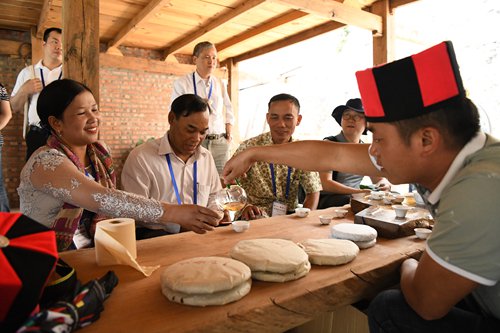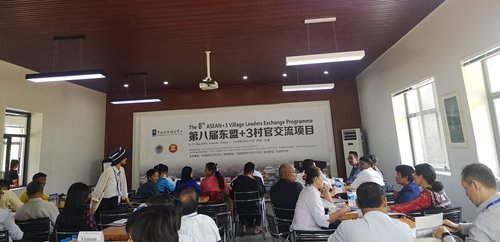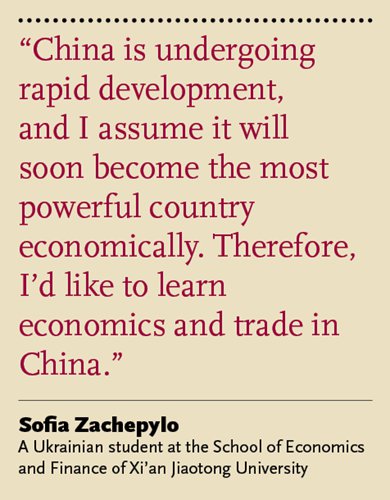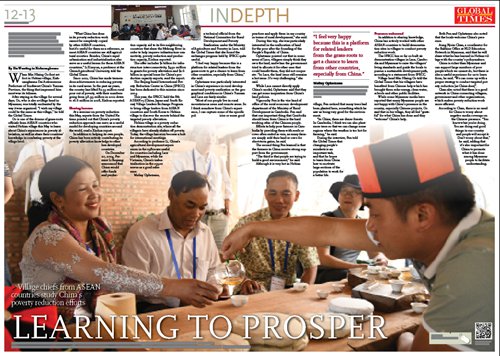HOME >> CHINA
Village chiefs from ASEAN countries study China’s poverty reduction efforts
By Xie Wenting in Xishuangbanna Source:Global Times Published: 2019/5/21 15:58:40
China's poverty reduction work has not only lifted hundreds of millions of people out of poverty, but also helped other countries combat extreme poverty. China is now actively sharing its experience with ASEAN countries through exchange programs as well as demonstration sites.

When Min Hlaing Oo first set foot in Hebian village, Xishuangbanna Dai Autonomous Prefecture of Southwest China's Yunnan Province, the thing that impressed him most was its tidiness.
After staying in the village for several days, Oo, who is also a village head in Myanmar, was totally enchanted by the way it was organized. "I wish my village could be the same as this village," he told the Global Times.
Oo is one of the dozens of grass-roots officials from ASEAN countries who visited Hebian village this May to learn about China's experiences in poverty alleviation, as well as share their countries' knowledge in combating poverty at the village level.
"What China has done in its poverty reduction work cannot be completely copied by other ASEAN countries, but it's useful for them as a reference, as most ASEAN countries are still agricultural societies. Besides, China's rapid urbanization and industrialization also serve as a useful lesson for these ASEAN countries," Li Xiaoyun, a professor at the China Agricultural University, told the Global Times.
Since 2012, China has made tremendous achievements in reducing poverty in its rural areas. In the past six years, the country has lifted 82.39 million rural poor out of poverty, with their numbers going from 98.99 million in 2012 down to 16.6 million in 2018, Xinhua reported.
Sharing lessons
At a seminar on poverty reduction this May, experts from the United Nations pointed out that China's poverty reduction approach can serve as a useful model for developing countries around the world, read a Xinhua report.
In addition to helping its own people, China has been actively contributing its poverty alleviation knowledge to other less developed countries.
On December 20, 2014, Premier Li Keqiang announced that China would offer funds and production capacity aid to its five neighboring countries that share the Mekong River in order to help improve infrastructure connectivity, poverty reduction and production capacity, Xinhua reported.
The offer includes $1 billion for infrastructure inter-connectivity, $490 million in grants for poverty alleviation and $1.6 billion in special loans for China's production capacity exports, read the report.
The Beijing-based International Poverty Reduction Center in China (IPRCC) has been dedicated to this mission since 2014.
This year, the IPRCC held the 8th ASEAN+3 (China, Japan and South Korea) Village Leaders Exchange Program to bring village leaders from ASEAN countries and South Korea to Hebian village to discover the secrets behind the targeted poverty alleviation.
Hebian village is a poverty reduction demonstration site, where all the villagers have already shaken off poverty. Today, the village has even become a hub for international meetings.

According to professor Li, China's agricultural development experiences in the 1980s are useful for countries including Laos and Myanmar, while for Vietnam, China's industrialization in the 1990s serves as a good reference.
Maliny Ophetsane, a technical official from the National Committee for Rural Development and Poverty Eradication under the Ministry of Agriculture and Forestry in Laos, told the Global Times that she found the exchanges program held by IPRCC quite useful.
"I feel very happy because this is a platform for related leaders from the grass-roots to get a chance to learn from other countries, especially from China," she said.
Ophetsane was particularly interested in China's experience in rural development and poverty eradication as the geographical conditions in China's Yunnan and Laos are fairly similar.
"Most of our people live in rural mountainous areas and remote areas. So I think somehow from China's experience, I can capture some of the specific policies or some good practices and apply them in my country in terms of rural development," she said.
During this trip, she was particularly interested in the reallocation of land for the poor after the founding of the People's Republic of China.
Ophetsane pointed out that in some areas of Laos, villagers simply think they own the land, and when the government tried to allocate it for other uses that could benefit them, they did not cooperate. "In Laos, the land issue still remains a hot issue. It's very challenging," she said.
While Laos cannot directly apply China's model, Ophetsane said that they can get some inspiration from China's land policies.

Efforts to help poor farmers in Cambodia by providing them with seeds or cows often ended in vain, as many farmers simply sold their land or cows for short-term gains, he said.
The second thing Pen learned is that the farmers in China receive strong support from the government.
"The third is that people are trying to build a good environment," he said.
Although it is very hot in Hebian village, Pen noticed that many trees had been planted here, something which he saw as being very good for the environment.
"In China, there are dense forests. In Cambodia, I think we can also plant more trees so that we can change some regions where the weather is too hot for farming," he said.
During the interview, Pen told the Global Times that changing people's mindsets is an important task, and that he hopes to learn from China how to motivate large sections of the population to work for a better life.
Presence welcomed
In addition to sharing knowledge, China has actively worked with other ASEAN countries to build demonstration sites in villages to conduct poverty reduction work.
The IPRCC has so far co-built six demonstration villages in Laos, Cambodia and Myanmar to raise the villagers' living standards and guide the locals to pursue a sustainable development path, according to a statement from IPRCC.
Village head Min Hlaing Oo told the Global Times that his villagers have benefited from Chinese help which has brought them solar energy, clean water, schools and other public facilities.
While some Myanmar media have reported that many Myanmar people are not happy with China's presence in the country, especially Chinese projects, Oo said that in his village, they all feel "grateful" for what China has done and they "welcome" China's help.
Both Pen and Ophetsane also noted that the locals welcome China's presence.
Aung Nyein Chan, a coordinator for the Rakhine Office at NLD Education Network in Myanmar, said that he will share what he has learned in Hebian village with the country's policymakers.
China is richer than Myanmar and can support large numbers of poor people which we cannot do, but there is also a useful experience for us to learn from, he said. "We can come up with a proper strategy to conduct targeted poverty reduction [as China does]".
Chan also noted that there is a good network in China connecting villagers, government and other organizations, which makes poverty reduction work more efficient.
According to Chan, there is no need for China to worry about negative media coverage on the Chinese presence. "You know what you're doing. You are doing real good things in our country and people will accept it. Don't worry about that," he said, adding that it's also important for China to promote what it has done among Myanmar people to facilitate understanding.

Newspaper headline: Learning to prosper

Village officials from ASEAN countries participate in a cultural activity at Hebian village, Southwest China's Yunnan Province in May. Photo: IPRCC
When Min Hlaing Oo first set foot in Hebian village, Xishuangbanna Dai Autonomous Prefecture of Southwest China's Yunnan Province, the thing that impressed him most was its tidiness.
After staying in the village for several days, Oo, who is also a village head in Myanmar, was totally enchanted by the way it was organized. "I wish my village could be the same as this village," he told the Global Times.
Oo is one of the dozens of grass-roots officials from ASEAN countries who visited Hebian village this May to learn about China's experiences in poverty alleviation, as well as share their countries' knowledge in combating poverty at the village level.
"What China has done in its poverty reduction work cannot be completely copied by other ASEAN countries, but it's useful for them as a reference, as most ASEAN countries are still agricultural societies. Besides, China's rapid urbanization and industrialization also serve as a useful lesson for these ASEAN countries," Li Xiaoyun, a professor at the China Agricultural University, told the Global Times.
Since 2012, China has made tremendous achievements in reducing poverty in its rural areas. In the past six years, the country has lifted 82.39 million rural poor out of poverty, with their numbers going from 98.99 million in 2012 down to 16.6 million in 2018, Xinhua reported.
Sharing lessons
At a seminar on poverty reduction this May, experts from the United Nations pointed out that China's poverty reduction approach can serve as a useful model for developing countries around the world, read a Xinhua report.
In addition to helping its own people, China has been actively contributing its poverty alleviation knowledge to other less developed countries.
On December 20, 2014, Premier Li Keqiang announced that China would offer funds and production capacity aid to its five neighboring countries that share the Mekong River in order to help improve infrastructure connectivity, poverty reduction and production capacity, Xinhua reported.
The offer includes $1 billion for infrastructure inter-connectivity, $490 million in grants for poverty alleviation and $1.6 billion in special loans for China's production capacity exports, read the report.
The Beijing-based International Poverty Reduction Center in China (IPRCC) has been dedicated to this mission since 2014.
This year, the IPRCC held the 8th ASEAN+3 (China, Japan and South Korea) Village Leaders Exchange Program to bring village leaders from ASEAN countries and South Korea to Hebian village to discover the secrets behind the targeted poverty alleviation.
Hebian village is a poverty reduction demonstration site, where all the villagers have already shaken off poverty. Today, the village has even become a hub for international meetings.

Participants of the 8th ASEAN+3 Village Leaders Exchange Program attend class at Hebian village, Southwest China's Yunnan Province on May 6. Photo: Xie Wenting/GT
According to professor Li, China's agricultural development experiences in the 1980s are useful for countries including Laos and Myanmar, while for Vietnam, China's industrialization in the 1990s serves as a good reference.
Maliny Ophetsane, a technical official from the National Committee for Rural Development and Poverty Eradication under the Ministry of Agriculture and Forestry in Laos, told the Global Times that she found the exchanges program held by IPRCC quite useful.
"I feel very happy because this is a platform for related leaders from the grass-roots to get a chance to learn from other countries, especially from China," she said.
Ophetsane was particularly interested in China's experience in rural development and poverty eradication as the geographical conditions in China's Yunnan and Laos are fairly similar.
"Most of our people live in rural mountainous areas and remote areas. So I think somehow from China's experience, I can capture some of the specific policies or some good practices and apply them in my country in terms of rural development," she said.
During this trip, she was particularly interested in the reallocation of land for the poor after the founding of the People's Republic of China.
Ophetsane pointed out that in some areas of Laos, villagers simply think they own the land, and when the government tried to allocate it for other uses that could benefit them, they did not cooperate. "In Laos, the land issue still remains a hot issue. It's very challenging," she said.
While Laos cannot directly apply China's model, Ophetsane said that they can get some inspiration from China's land policies.

Vignouchy Pen is the vice head of office of the rural economic development department of the Ministry of Rural Development in Cambodia. Pen said that one important thing that Cambodia should learn from China is the hard working ethic of the Chinese people.
Efforts to help poor farmers in Cambodia by providing them with seeds or cows often ended in vain, as many farmers simply sold their land or cows for short-term gains, he said.
The second thing Pen learned is that the farmers in China receive strong support from the government.
"The third is that people are trying to build a good environment," he said.
Although it is very hot in Hebian village, Pen noticed that many trees had been planted here, something which he saw as being very good for the environment.
"In China, there are dense forests. In Cambodia, I think we can also plant more trees so that we can change some regions where the weather is too hot for farming," he said.
During the interview, Pen told the Global Times that changing people's mindsets is an important task, and that he hopes to learn from China how to motivate large sections of the population to work for a better life.
Presence welcomed
In addition to sharing knowledge, China has actively worked with other ASEAN countries to build demonstration sites in villages to conduct poverty reduction work.
The IPRCC has so far co-built six demonstration villages in Laos, Cambodia and Myanmar to raise the villagers' living standards and guide the locals to pursue a sustainable development path, according to a statement from IPRCC.
Village head Min Hlaing Oo told the Global Times that his villagers have benefited from Chinese help which has brought them solar energy, clean water, schools and other public facilities.
While some Myanmar media have reported that many Myanmar people are not happy with China's presence in the country, especially Chinese projects, Oo said that in his village, they all feel "grateful" for what China has done and they "welcome" China's help.
Both Pen and Ophetsane also noted that the locals welcome China's presence.
Aung Nyein Chan, a coordinator for the Rakhine Office at NLD Education Network in Myanmar, said that he will share what he has learned in Hebian village with the country's policymakers.
China is richer than Myanmar and can support large numbers of poor people which we cannot do, but there is also a useful experience for us to learn from, he said. "We can come up with a proper strategy to conduct targeted poverty reduction [as China does]".
Chan also noted that there is a good network in China connecting villagers, government and other organizations, which makes poverty reduction work more efficient.
According to Chan, there is no need for China to worry about negative media coverage on the Chinese presence. "You know what you're doing. You are doing real good things in our country and people will accept it. Don't worry about that," he said, adding that it's also important for China to promote what it has done among Myanmar people to facilitate understanding.

Newspaper headline: Learning to prosper